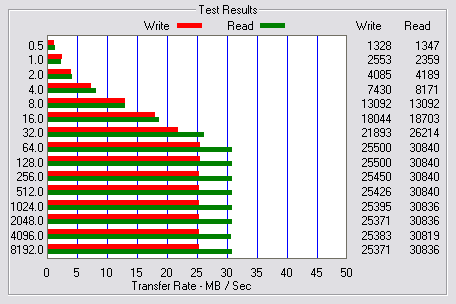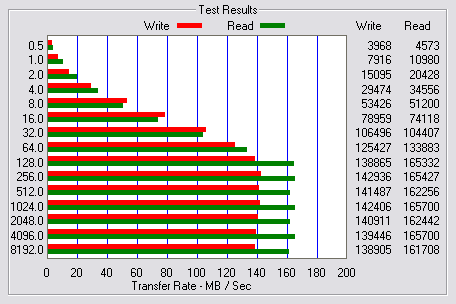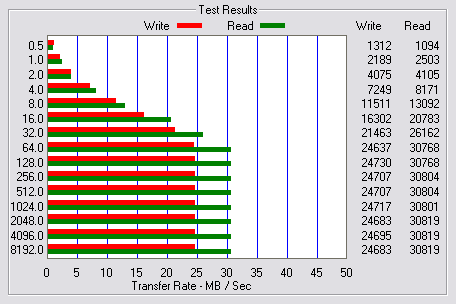The test system used in this review was an HP dc7900. The computer came equipped with an Intel Core 2 Duo E8400 3.0GHz CPU, 2GB of DDR2 800MHz memory, Seagate Barracuda 7200.10 ST3250310AS 250GB SATA hard drive, NVIDIA Quadro FX570 256MB PCIe graphics card and Intel 82567LM-3 gigabit network card. For the operating system, I installed a fresh copy of Windows XP with Service Pack 3.
To test the performance of the HornetTek X2-RAID, I ran a series of benchmarks using HD Tach RW 3.0.4.0 and ATTO Disk Benchmark 2.34. The tests were run using a pair of Hitachi Deskstar 1TB 7K1000.B hard drives configured first as a RAID 0 volume and then again as a RAID 1 volume.
HD Tach RW 3.0.4.0:
Using HD Tach, we can benchmark a drive's read, write and burst speeds as well as its seek times and CPU usage.
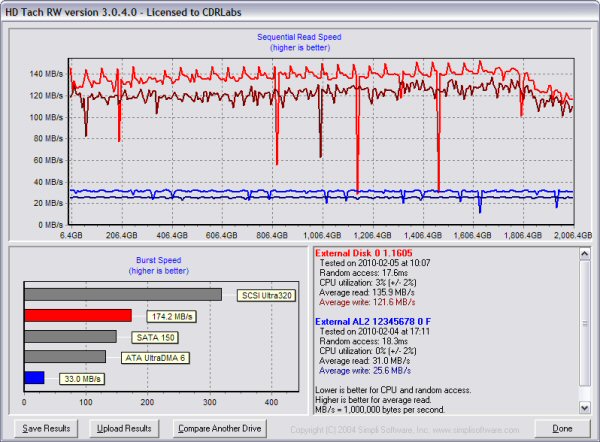
USB 2.0 vs eSATA - RAID 0
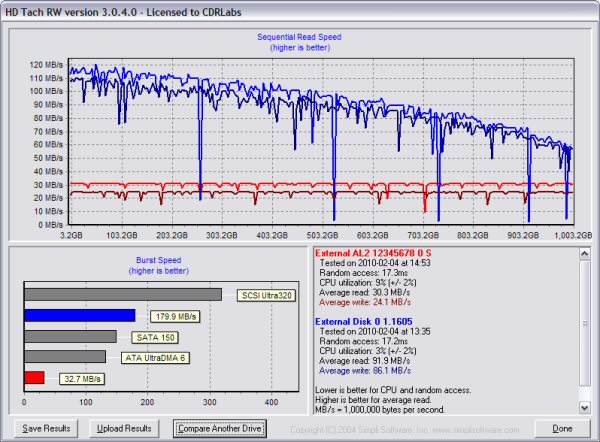
USB 2.0 vs eSATA - RAID 1
Looking at the screenshots above, you can see that the X2-RAID performed very well when using its eSATA interface. While faster when configured for RAID 0, the enclosure showed some impressive read and write speeds in both modes. The X2-RAID wasn't nearly as fast when using its USB 2.0 interface. However, it performed as well as can be expected, reading and writing at speeds averaging from 24MB/s to 31MB/s.
ATTO Disk Benchmark 2.34:
I also used ATTO Disk Benchmark to test the X2-RAID's sequential read and write speeds. The tests are run using blocks ranging in size from 0.5KB to 8192KB and the total length set to 512MB.
Once again, the X2-RAID performed very well when using its eSATA interface. With the two hard drives configured for RAID 0, the read and write speeds topped out at about 160MB/s and 140MB/s, respectively. The X2-RAID's performance took a hit when configured for RAID 1. However, the enclosure still reached speeds in excess of 116MB/s when reading and writing.
Final Thoughts:
The X2-RAID is the first drive enclosure from HornetTek to come through the 'Labs and to be honest, they could not have made a better first impression. Along with a well-constructed and functional design, this dual bay enclosure offers great performance and a number of useful features. The X2-RAID's SteelVine SiI5744 storage processor enables both USB 2.0 and eSATA connection options as well as an almost overwhelming number of RAID options. Along with the standard RAID 0, RAID 1, JBOD and BIG modes, the enclosure supports two multi-RAID modes that are capable of delivering the benefits of capacity and protection with only two drives.
My only real complaint was the software that comes with the X2-RAID. As useful as the SteelVine Manager software is, the interface is dated and a bit clunky at times. I was also a bit disappointed that HornetTek did not include Mac and Linux versions on the CD or even mention that they are available for download from Silicon Image's website. If HornetTek is going to advertise Mac and Linux support on the box, this is definitely a must.
The HornetTek X2-RAID is available now and can be purchased from online vendors like Micro Center and Provantage for as little as $56.
Highs:
- Well constructed
- Great eSATA performance
- Supports RAID 0, RAID 1, JBOD, BIG, SAFE 33 and SAFE50 configurations
- eSATA and USB 2.0 interfaces
- Cooling fan can be turned on or off
- Compatible with Windows, Mac and Linux
- Reasonably priced
Lows:
- SteelVine Manager software looks dated
- Does not include software for Mac and Linux


